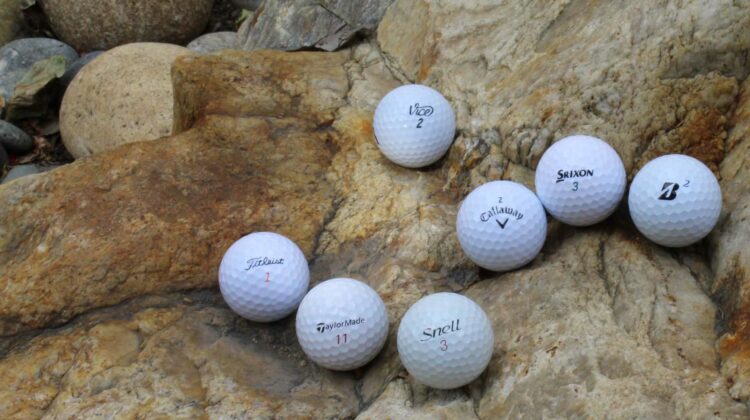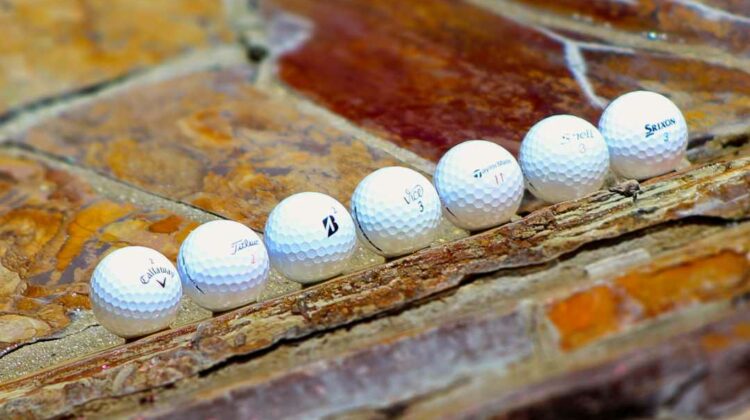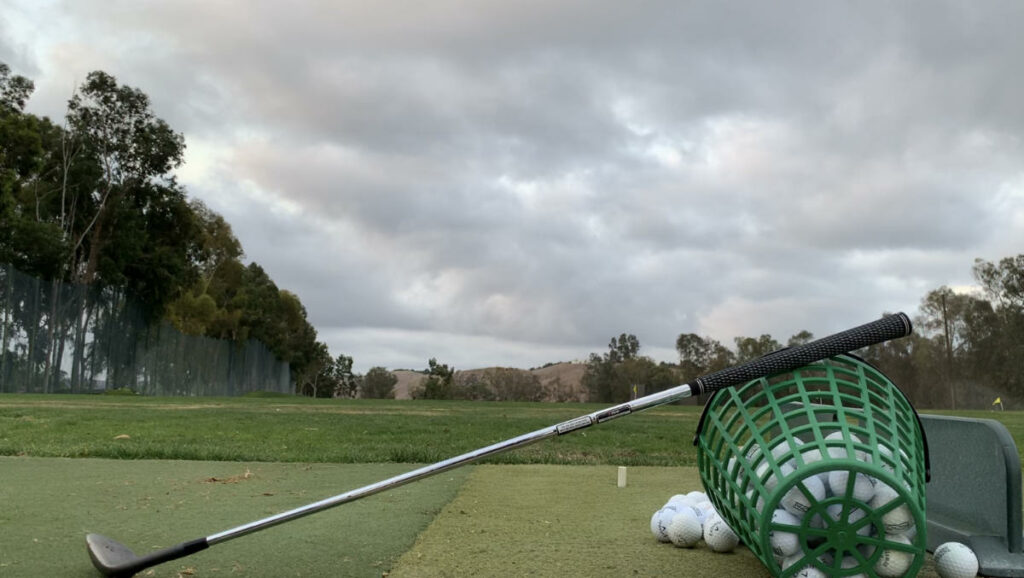
Club fittings are all the rage in the golf world these days. I can’t remember the last time I saw new clubs that didn’t come with an invitation to get ‘properly fit’. But what about a golf ball fitting?
I can guarantee I’ve never bought a golf ball that came with an invitation to see if it’s actually a ball that will help my game. Seems confusing to me considering the golf ball is what we use on every single shot. Getting a ‘proper’ golf ball fitting appears to be missing in action through most of golf. (See 6 things to avoid when picking your golf ball.)
While some manufacturers are increasing their emphasis on the importance of playing the correct ball, we are still far from a mass takeover of ball fittings.
Perhaps they get overlooked because balls don’t come in different shapes and sizes like clubs do, therefore the differences in balls are often subtle and unnoticeable to the naked eye.
Or should I say, untrained eye.
If you need convincing, go back and watch Tiger Woods win the 2000 US Open by 15 strokes… He had just changed his golf ball.
Color variations and subtle dimple patterns aside, every ball looks exactly the same from the outside. The exact same size and (hopefully) a perfect sphere.
But for golf balls, as in life, it’s what’s on the inside that counts.
How many layers is it? How thick are the layers? Are the layers firm? Are they soft? What do the layers even do?… Are you sensing a theme yet?
It’s all about the layers.
And every golf ball is constructed with a different number of layers with different densities all in an effort to help us hit better golf shots.
If you’ve never cut a ball open yourself, you’re not blamed for believing all golf balls are close enough in their construction that it doesn’t really matter which one you play.
Especially if you are a high handicapper.
Unfortunately, that couldn’t be further from the truth.
In fact, I would argue, a high-handicappers can often benefit more by playing a proper golf ball that fits their game.
Once you believe a proper golf ball can help lower your scores, or if you just want to take a leap of faith, the next question is the hardest one you’ll ever have to answer.

How do you know which ball is best for your game?
Knowing what golf ball will help you score better can be a daunting and overwhelming task.
It’s a decision so convoluted that many of us simply avoid the decision altogether.
Instead, we play the first ball we see in our bag. Or worse, we play the ball recommended by our golf buddy who is just as dazed and confused as we are.
Needless to say, this is NOT the path to playing your best round of golf.
Fortunately, there is a path that can help you shoot lower scores. And it starts with getting fit for your golf ball.
Additionally, there is good news!
There is more than one golf ball that will fit your game well. You just have to find one of them.
Every golf company has its own version of an online fitting tool, but they are all very different.
Not to mention, some are far superior to the rest.
For example, some ask you three questions. Some ask ten. And it’s hard to know how accurate they are no matter the number of questions they ask.
After all, do you really know how much your current golf ball spins?
The main point, these tools are nothing more than rough estimates about your game with very little raw data to go off of.
I won’t even talk about how none of these companies will ever recommend a ball made by a competitor.
So how do you truly know what golf ball is best for you?
You have to test, test, test!
>> Related: Best Titleist Golf Balls
How to Start Your Own Golf Ball Fitting
The first thing on your list should be to identify your performance objectives and feel preferences.
Feel is simpler as your options pretty much boil down to firm or soft. There are varying degrees of that, however, and I think we’d all agree that a softer ball ‘feels’ better.
With that said, there are factions that believe feel is overrated (hand up, I’m in that faction), but you’re the one that has to hit your shots, so put as much emphasis on it as you see fit.
I’m of the belief that you do get performance benefits from firmer balls that physics simply can’t achieve with softer ones, but again, you’re the one hitting your shot.
When it comes to performance, we start by looking at three things: distance, spin, and trajectory (max height, descent angle, launch angle, etc. can all be grouped into trajectory).
Assuming we all want a golf ball that goes farther, it’s time to decide what fits our game best with the other characteristics. Do you need help spinning the ball? Is your trajectory too low? Too high?
These are the questions you can, and should, ask yourself before even starting your fitting.
Once you’ve decided what your objectives are, it’s time to choose the balls you want to test.
This part can get a tad overwhelming (our ball guide has over 30 balls alone), but some basic golf ball knowledge might help.
Most companies make two tour balls.
By nature one of them is going to be softer than the other firmer.
The firmer ball will generally produce higher ball speeds. Especially the faster you swing.
Also, a higher trajectory with less spin will usually create a farther carry distance. However, those characteristics could also lead to less stopping power around the greens.
Yes, it’s a bit more complicated than just those few simple rules, but that’s why we are here. To go test some golf balls!
As mentioned, the fun part starts after you’ve found some golf balls that fit your preferences.
If you don’t know where to start, I would highly suggest starting with a Titleist Pro V1 and working off that.
It will perform as a good middle-ground option for almost any golf ball characteristic you could want. (For a quick guide on what golf balls produce which performance features, see this post of almost every golf ball on the market.)
Furthermore, if you’ve never done this before, I would start with somewhere around 3-5 different balls. Each with varying performance strengths and see where the options take you.
If you notice the choices don’t fit your game, don’t hesitate to drop them and try a different ball.
Without further ado, it’s time to hit the course and start your personal golf ball fitting.
Golf Ball Fitting on the Green
I know most of you already know it, but sometimes it bears repeating. Nearly one-third of all golf shots are hit with the flat stick.
One-third!
That laps every other club in the bag by a wide margin.
Almost every time I play a round of golf there is almost always a club or two that I realize I haven’t touched by the 14th or 15th hole.
Makes you think twice about that club fitting, doesn’t it?
For this reason, I always recommended starting a golf ball fitting on the putting green.
Your goal here is to feel how firm each ball is and how they react off the putter face.
While I noted before that feel and sound can be overvalued at times, they are still important when starting the golf ball fitting process.
If for no other reason than to know what feel to expect on a cleanly struck shot.
After all, you are the one who has to hit it on every shot.
And even if you are not phased by the different feels, I still believe it’s important to be aware of the feel of your ball.
At this point, I would not eliminate any balls from your fitting unless there is a CLEAR loser in the bunch.
The next phase will start helping you identify what balls can help lower your scores.
Around the Green
These next two phases are probably the most important steps of the entire golf ball fitting process.
You can start this step by hitting some short chip shots around the green and vary it by finding different lies and angles to try and account for anything you might encounter during a round of golf.
Bonus points if you can get out and do this on a real golf hole.
For perspective, an average golfer has a handicap of just over 16, which means they are only hitting four or five greens in regulation per round.
You can judge your own game based on that statistic, but this means an average golfer has to hit around 14 short game/recovery shots every round.
That makes this recovery area one of the most important for saving tough pars and keeping scores low.
Due to the wide variety of shots that we all see around the greens, I recommend spending the most time in this area.
Again, try finding different lies, different slopes, and varying amounts of green to work with, and attempt as many different shots as you can with each ball.
Your goal here is to evaluate how each ball is reacting on different shot types.
Do you like playing bump-and-runs? Or do you prefer a bounce-and-check?
Make sure your ball is reacting how you want it to as this part of the golf ball fitting could be the difference between par and bogey.
Feel free to remove any balls from your fitting now that don’t fit your style of play.
Pro tip: This part of the test could be the hardest as it’s not always easy to find a proper short game area depending on where you live. If you’re like me and the only decent short-game areas cost a fee, pay the fee. It’s worth it to get this part right and know how your game can benefit.
Scoring Shots
Generally thought of as wedges and short irons, scoring shots are the part of your game that are going to separates good rounds from bad rounds.
For that reason, make sure you pay extra close attention to how each ball is reacting (more importantly, stopping) on the green.
The biggest difference you will see with these shots is the spin and descent angle.
The name of the game is getting the ball to stop as close to its pitch mark as possible.
Depending on your ability, you may be able to produce more spin on these shots compared to others.
If you are that person, you may not need a ball that induces quite so much spin spin.
However, some players like to get as much spin as they can to improve their workability.
As long as you know how to control that extra spin, feel free to keep that high-spinning ball in your repertoire.
And if you have a harder time getting the ball to stop, then definitely keep that higher-spinning ball.
Your objective here is to evaluate your own game and match your preference to the ball you wanna play.
Again, there will be multiple balls that fit your game well. You just need to find one of them.
Note: Spin is not the only thing that affects a ball’s ability to stop. The higher a ball’s trajectory usually means it falls with a steeper descent angle and aids in its stopping power. Just some added food for thought.
Generally speaking, eliminating extra roll-out is the name of the game for these shorter clubs.
And a ball that comes to rest close to its pitch mark is usually best practice.
After this phase, you should have two, maybe three, balls left in your golf ball fitting.
Yes, you should already have it narrowed down that much!
>> Related: What is Wedge Bounce

Mid-to-Long Irons
Your goal with mid-to-long irons is to see which ball gives you the trajectory and workability you want.
See which ball has the highest peak trajectory (without ballooning), and this can give you a good idea of which ball will land softest.
While you’re at it, be on the lookout for which balls you can draw or fade to your liking.
Some of us prefer as straight a ball flight as possible, while others trust maneuverability.
This is a true ‘to each their own’ situation and you have to find your north star.
Side note: Without data from a shot-tracking system like Trackman, this can be hard to quantify. However, the goal is to get a general idea. If you have access to Trackman or can pay for a session with a hitting bay somewhere, I would absolutely jump on it and see what numbers jump out at you with the different balls.
If you don’t like how your ball is reacting with these longer irons, don’t panic!
You can always go back to some of the shorter distances and test some other balls again.
Just remember the most important shots for scoring are going to come from the shorter distances.
It’s much easier to adjust your long game to the ball that fits your short game than the other way around.
At this point you should have your choice all narrowed down.
You have found your ball!
But you’re not quite done yet.
Tee Shots
On that note, surprising to some amateur golfers, it’s not recommended to pick a golf ball based on driver tests.
Only one man has ever done that and his name was John Daly. If you can hit a golf ball like John Daly, you probably don’t need my advice anyway.
You would be forgiven for walking into a golf store to see everybody testing drivers and thinking the big stick is the most important shot in the bag.
While it might get the most attention, it’s not the most important club for picking the correct ball.
With the accepted variance in drives, it doesn’t make much sense to pick a golf ball based on your driver.
This is not to say a driver is not an important club, it’s just not the one you should be using to choose your best golf ball.
In reality, the best way to marry a driver and a golf ball is to change the characteristics of the driver to fit the ball.
In other words, adjusting the driver to fit the golf ball that fits your short game will be the most efficient way of maximizing your drives.
Therefore, the best recommendation is to fit a ball to your short game and then fit your driver to that ball.
Golf Ball Fitting – Play Test
By now you will surely have hit hundreds of shots with all different clubs and all different balls.
The only thing left to finish your golf ball fitting is to go play!
If you’ve done all the steps above, going out and playing a quick nine holes (or 18, I won’t stop you) will be the final test for your new ball.
If you’ve done your job, you should see a noticeable difference in your ability to put the ball in the hole.
And the best part is, you can keep testing new balls as your game evolves.
The cycle of amateur golf immortality is a vicious one, but an oh-so-sweet one!
Good luck out there.
Happy golfing!



Leave a Reply